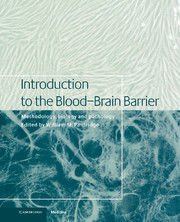Book contents
- Frontmatter
- Contents
- List of contributors
- 1 Blood–brain barrier methodology and biology
- Part I Methodology
- 2 The carotid artery single injection technique
- 3 Development of Brain Efflux Index (BEI) method and its application to the blood–brain barrier efflux transport study
- 4 In situ brain perfusion
- 5 Intravenous injection/pharmacokinetics
- 6 Isolated brain capillaries: an in vitro model of blood–brain barrier research
- 7 Isolation and behavior of plasma membrane vesicles made from cerebral capillary endothelial cells
- 8 Patch clamp techniques with isolated brain microvessel membranes
- 9 Tissue culture of brain endothelial cells – induction of blood–brain barrier properties by brain factors
- 10 Brain microvessel endothelial cell culture systems
- 11 Intracerebral microdialysis
- 12 Blood–brain barrier permeability measured with histochemistry
- 13 Measuring cerebral capillary permeability–surface area products by quantitative autoradiography
- 14 Measurement of blood–brain barrier in humans using indicator diffusion
- 15 Measurement of blood–brain permeability in humans with positron emission tomography
- 16 Magnetic resonance imaging of blood–brain barrier permeability
- 17 Molecular biology of brain capillaries
- Part II Transport biology
- Part III General aspects of CNS transport
- Part IV Signal transduction/biochemical aspects
- Part V Pathophysiology in disease states
- Index
17 - Molecular biology of brain capillaries
from Part I - Methodology
Published online by Cambridge University Press: 10 December 2009
- Frontmatter
- Contents
- List of contributors
- 1 Blood–brain barrier methodology and biology
- Part I Methodology
- 2 The carotid artery single injection technique
- 3 Development of Brain Efflux Index (BEI) method and its application to the blood–brain barrier efflux transport study
- 4 In situ brain perfusion
- 5 Intravenous injection/pharmacokinetics
- 6 Isolated brain capillaries: an in vitro model of blood–brain barrier research
- 7 Isolation and behavior of plasma membrane vesicles made from cerebral capillary endothelial cells
- 8 Patch clamp techniques with isolated brain microvessel membranes
- 9 Tissue culture of brain endothelial cells – induction of blood–brain barrier properties by brain factors
- 10 Brain microvessel endothelial cell culture systems
- 11 Intracerebral microdialysis
- 12 Blood–brain barrier permeability measured with histochemistry
- 13 Measuring cerebral capillary permeability–surface area products by quantitative autoradiography
- 14 Measurement of blood–brain barrier in humans using indicator diffusion
- 15 Measurement of blood–brain permeability in humans with positron emission tomography
- 16 Magnetic resonance imaging of blood–brain barrier permeability
- 17 Molecular biology of brain capillaries
- Part II Transport biology
- Part III General aspects of CNS transport
- Part IV Signal transduction/biochemical aspects
- Part V Pathophysiology in disease states
- Index
Summary
Introduction
The brain microvascular endothelium represents the Blood–brain barrier (BBB) in vivo (Brightman, 1977), and the expression of BBB-specific genes provides the anatomical and biochemical properties of this barrier (i.e. tight junctions, nutrient transporters, etc.). Because only lipophilic molecules of less than 600 Da diffuse through the BBB (Pardridge, 1995), the brain is protected against peripheral neurotransmitters (i.e. nor adrenaline), cytotoxins, and microorganisms. From the pharmacological point of view, the protective properties of the BBB represent a disadvantage for brain drug delivery of hydrophilic therapeutics (for example, AZT, antisense oligodeoxynucleotides, nerve growth factor) for the treatment of cerebral HIV-AIDS, brain tumors, Alzheimer's disease and other brain disorders (Boado, 1995a; Pardridge, 1995). On the contrary, polar nutrients, as in the case of glucose and amino acids, and peptides like insulin, gain access to the brain through specific transporters located on both lumenal and ablumenal membranes of the BBB (see Chapter 6). Although the mechanism of gene expression of BBB-specific proteins appears to be directed by factors released by brain cells (i.e. astrocytes) and sequestered by the endothelium (Stewart and Wiley, 1981), little is known in regards to either the identification or isolation of these putative brain trophic factors. This intellectually stimulating field has captivated the attention of several groups of investigators over the last couple of decades, and the progress has been limited to the development of reproducible cell culture models and to the initial characterization of brainderived complex fractions possessing trophic properties.
- Type
- Chapter
- Information
- Introduction to the Blood-Brain BarrierMethodology, Biology and Pathology, pp. 151 - 162Publisher: Cambridge University PressPrint publication year: 1998
- 4
- Cited by



